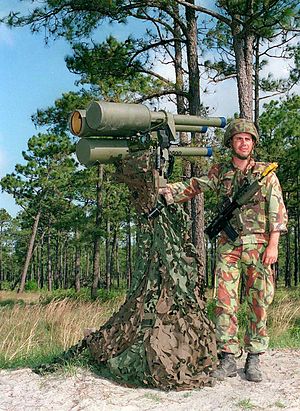avia.wikisort.org - Weapon
Javelin is a British man-portable surface-to-air missile, formerly used by the British Army and Canadian Army. It can be fired from the shoulder, or from a dedicated launcher named the Lightweight Multiple Launcher (LML), that carries three rounds, and can be vehicle mounted.
| Javelin | |
|---|---|
 British soldier posing with Javelin triple launcher (1996) | |
| Type | Manportable surface-to-air missile |
| Place of origin | United Kingdom |
| Service history | |
| Used by | See Operators |
| Production history | |
| Manufacturer | Thales Air Defence |
| Specifications | |
| Mass | 11.1 kilograms (24 lb) (missile) 24.3 kilograms (54 lb) (system) |
| Length | 1.39 metres (4 ft 7 in) |
| Diameter | 76 millimetres (3 in) |
| Crew | 1 |
| Effective firing range | 300 to 4,500 metres (980 to 14,760 ft) against jets to 5,500 metres (18,000 ft) against helicopters |
| Warhead | High-explosive warhead |
| Warhead weight | 2.74 kilograms (6.0 lb) (containing 0.6 kilograms (1.3 lb) of HE) with contact and proximity fuzes |
Detonation mechanism | Impact force or proximity fuze |
| Engine | Solid fuel rocket |
| Maximum speed | Mach 1.7+ approx. |
Guidance system | SACLOS system |
The missile is an updated version of the earlier Blowpipe of the 1970s. Blowpipe used a manual guidance system which proved almost useless in combat during the Falklands War where 100 firings resulted in two hits. Javelin replaced the manual guidance system with a semi-automatic command to line of sight (SACLOS) system that only required the operator to keep their gunsight pointed at the target. A tracking system in the launcher's optics compared the location of the missile to the line-of-sight and sent it commands over a radio link to guide it. This version entered service in 1984, and was later known as Javelin GL.
Further upgrades to the missile added a fully automatic guidance system to produce the Javelin S-15. This was sold commercially, and is better known, as the Starburst surface-to-air missile. These began to replace the GL in British Army service in 1993, although the GL remained in use as a training system. Both were replaced by Starstreak starting around 1997.[1]
Javelin GL was hastily purchased by the Canadian Forces to replace the Blowpipes that failed last-minute tests during preparations for the deployment to the Persian Gulf for the First Gulf War (1990–1991).[2][3][4] It was later replaced by the Javelin S15 until retired without replacement in 2005.
History
The missile was developed as a replacement for the Blowpipe MANPADS, which was used in the Falklands War by both sides, and proved largely ineffective. Only two hits were recorded out of more than 100 launches: a British Harrier GR3 (XZ972) attacked by Argentine Army special forces (Commandos Company), and an Argentine Aermacchi MB-339 (0766 (4-A-114)) during the Battle of Goose Green.[5]
Operational use
Similar in overall appearance to the manual command to line of sight (MCLOS), radio frequency guided Blowpipe, Javelin is slightly smaller, uses semi-automatic command to line of sight (SACLOS) radio frequency guidance and is fitted with an improved warhead. The operator is equipped with a 6× magnification sight and a long range television (TV) camera to locate targets. Although the Javelin's accuracy is somewhat susceptible to smoke, fog, or clouds, it cannot be decoyed away from a target with flares because it does not use an infrared or ultraviolet (UV) spectrum seeker. It is potentially susceptible to infrared jammers such as AN/ALQ-144.
Operators

Current operators
 Botswana
Botswana-
- In 1991 the Botswana Defence Force procured 25 missiles with five launchers[6]
 Malaysia
Malaysia
- Malaysian Armed Forces
 Peru
Peru
- Peruvian Army
 South Korea
South Korea
- Republic of Korea Army
Former operators
 Canada
Canada-
- Canadian Army
 United Kingdom
United Kingdom-
- British Army
- Royal Marines
See also
References
- "Thales Javelin". Military Factory (MilitaryFactory.com). Retrieved 25 May 2021.
- Thatcher, Chris (21 December 2017). "Critical Gap: Defending the Threat from Above". Canadian Army Today. Retrieved 21 January 2022.
- "The Navy Today: The Gulf War: Javelin Surface-to-Air Missile". Canadian War Museum. Retrieved 21 January 2022.
- rca_admin (27 September 2020) [1 January 2017]. "Javelin Surface to Air Missile UK". Royal Canadian Artillery Museum. Retrieved 21 January 2022.
- Freedman, Lawrence, Sir (31 May 2004). The Official History of the Falklands Campaign: War and Diplomacy. Vol. 2. Abingdon. pp. 732–735. ISBN 978-0415419116.
- Motlogelwa, Tshireletso (13 April 2012). "Khamas monopolised Botswana Defence Force (BDF) tenders". XairForces.
- Jane's Land-Based Air Defence 2005–2006, ISBN 0-7106-2697-5
- "Javelin".
- "Javelin Surface-to-Air Missile".
На других языках
[de] Javelin (Luftabwehrrakete)
Die Javelin ist eine Flugabwehrrakete aus britischer Produktion. Das System ist von einem Mann einsetzbar und dient zur Bekämpfung tieffliegender Ziele.- [en] Javelin (surface-to-air missile)
[it] Javelin (missile SAM)
Lo Shorts Missile Systems Javelin, comunemente noto come Javelin, è un missile terra-aria spalleggiabile di produzione britannica. Versione migliorata del Blowpipe, è un missile a corto raggio a guida radio della Shorts, con buone prestazioni complessive.Другой контент может иметь иную лицензию. Перед использованием материалов сайта WikiSort.org внимательно изучите правила лицензирования конкретных элементов наполнения сайта.
WikiSort.org - проект по пересортировке и дополнению контента Википедии